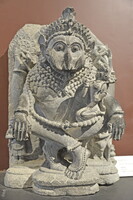| dc.coverage.spatial | Site: Prince of Wales Museum of Western India (Mumbai, Mahārāshtra, India) L/82.2/69 | en_US |
| dc.coverage.temporal | 13th century (creation) | en_US |
| dc.creator | unknown (Indian (South Asian)) | en_US |
| dc.date | 1200-1299 | en_US |
| dc.date.accessioned | 2016-08-23T18:14:06Z | |
| dc.date.available | 2016-08-23T18:14:06Z | |
| dc.date.issued | 1200-1299 | en_US |
| dc.identifier | 268046 | en_US |
| dc.identifier.other | archrefid: 3398 | en_US |
| dc.identifier.uri | http://hdl.handle.net/1721.3/184360 | |
| dc.description | Overall view; The fourth (of ten) avatara or 'descent' of the Hindu god Vishnu is Narasimha (or Narasingha), the man-lion. Narasimha is most often shown in the episode where he kills the demon Hiraṇyakasipu. In this form, representing divine anger, worship is very formal, sometimes only conducted by lifelong celibates (Brahmacarya). Forms where Narasiṁha appears sitting in a yogic posture, or with the goddess Lakṣmi (Lakshmi) are the exception to this rule, as Narasiṁha is taken as being more relaxed. In this statue from Orissa, Narasimha is shown in a composed, meditative pose, legs crossed in the lotus position with a meditation band around his knees. In his meditative portrayals he is often pictured with a wife or consort; the figure accompanying him in this statue could be his consort Lakshmi. His hands are in the Bhumisparsha mudra position. Source: Wikipedia; http://en.wikipedia.org/wiki/Main_Page (accessed 4/16/2015) | en_US |
| dc.format.medium | black stone | en_US |
| dc.rights | © Scott Gilchrist, Archivision, Inc. | en_US |
| dc.subject | deities | en_US |
| dc.subject | Hinduism | en_US |
| dc.title | Narasimha | en_US |
| dc.type | image | en_US |
| dc.rights.access | Licensed for educational and research use by the MIT community only | en_US |
| dc.identifier.vendorcode | 7A2-IN-PWM-SHA-A01 | en_US |
| vra.culturalContext | Indian (South Asian) | en_US |
| vra.technique | carving (processes) | en_US |
| vra.worktype | sculpture (visual work) | en_US |
| dc.contributor.display | unknown (Indian) | en_US |

